Too Many Books: DC Comics and Its Struggle to Find the Right Mix
While others are doing well, DC's quantity of releases seem to be bringing them down
Earlier today, I tried to answer the question “are there too many comics being published?” It’s one that many comic readers have lamented in recent years as the number of releases have risen in this boom time, but as I discovered, the volume of releases has played a big part in the industry being as successful as it has been. The larger release list has proven to be good for comics, at least for now.
But in the process of digging into this story, one publisher stood out in a way others didn’t. While the industry and its rivals have been prosperous, this one has only seen intermittent spikes of success despite it being the company that arguably set the industry on the path it’s on. So who is this publisher, and how is it struggling?
For the former question, the answer is DC Comics. The answer to the latter is a lot more complicated.
The Best Laid Plans
It was September of 2011. DC Comics was at the top of the comic world, having relaunched its entire line with its New 52 initiative, capturing the attention of the whole of mainstream media. Everyone from CNN to TMZ to the New York Times was talking about them. It seemed DC had pulled off a coup and that its plan had worked. Long-time and lapsed readers were interested alike. It was a time of great excitement.
However, efforts like the New 52 don’t become a success because of one month, but because of sustained success. What’s the point of change if you’re just back to the same old place a couple years later? The good news for DC is they’re still at a higher point than they were before the New 52, and they’re at a healthy point overall.
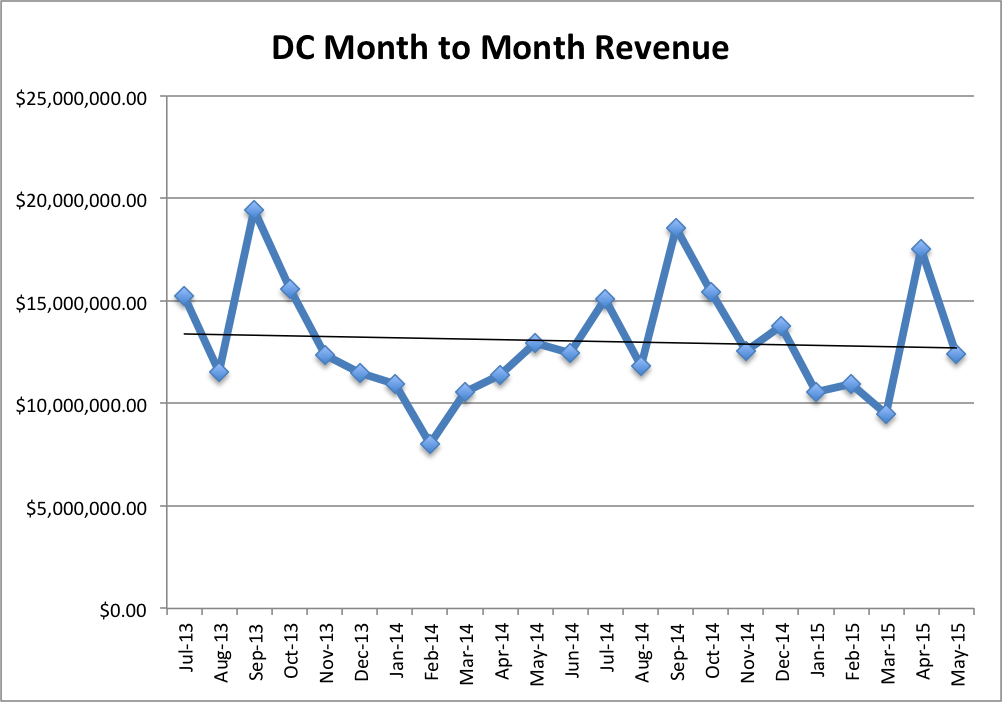
That initial New 52 month saw DC generate nearly $14 million in total revenue from their comics, and they’ve had higher revenue than the launch month eight times in the past 22 months. That level of success isn’t as perpetual, but it does come back at times. That’s good. The bad news is even with enormous months like the one they saw in April, DC’s revenues are still trending downwards. Things get even grimmer if you take just a few of their more successful, more anomalous months out of the equation.
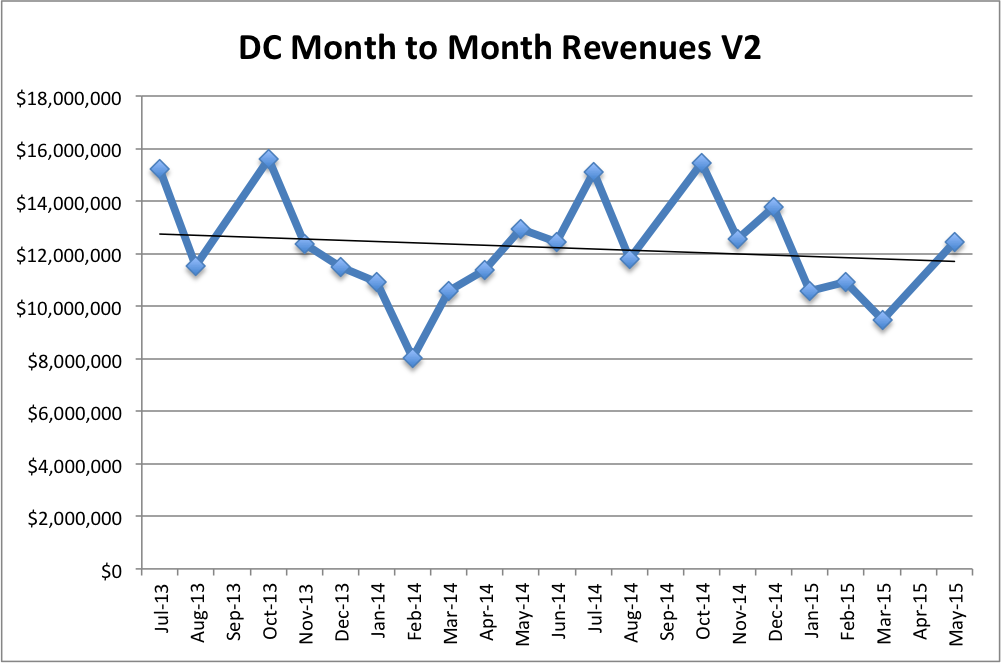
That’s an even more significant slope on the trend line when you run the numbers in such a way, and in a time of boom a decrease in revenue is concerning. DC’s downturn is being at least partially staved off by a few exceptional sales months. But what were those months propping DC up in the previous chart? The ones I removed? You could more than likely guess them, but they’re noted below.
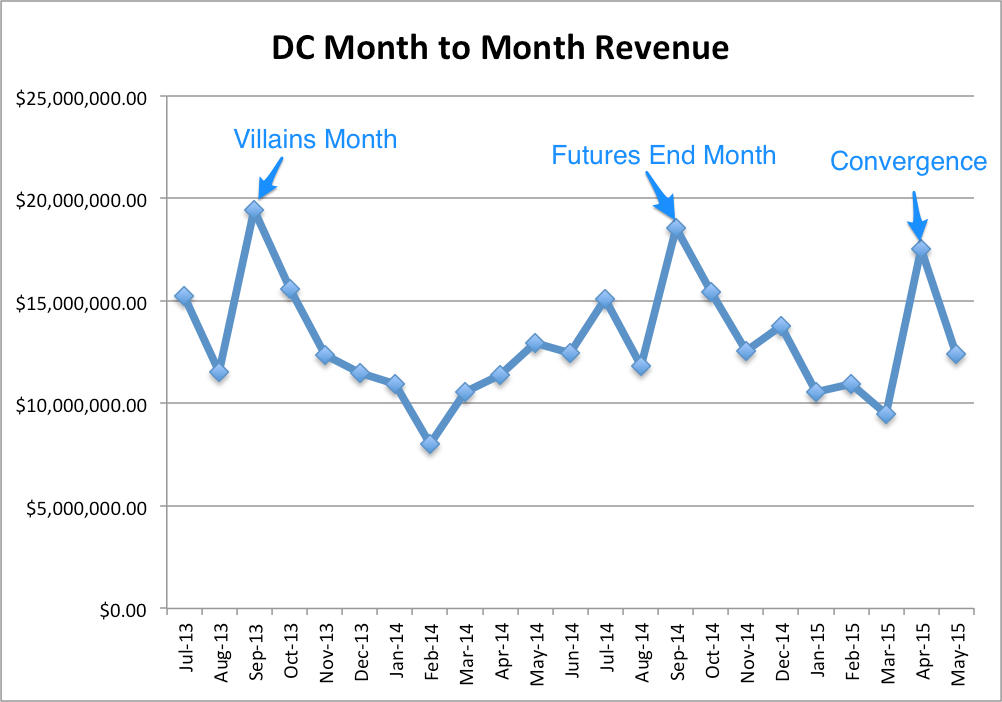
As you can see, the three biggest months DC has had in the last two years by far were its September lenticular cover months – Villains Month and Futures End Month – and April’s Convergence month. While it’s great to have any boost at all it’s hard not to see the way DC does it as being more artificial. Those three months have little to nothing to do with the natural state of DC Comics. Because of that, they’re more outliers than they are indicators of potential growth. That’s what DC wants, but it isn’t what they’re getting.
The decreasing revenue isn’t the concerning part of where DC is though. The biggest concern is where those numbers are coming from.
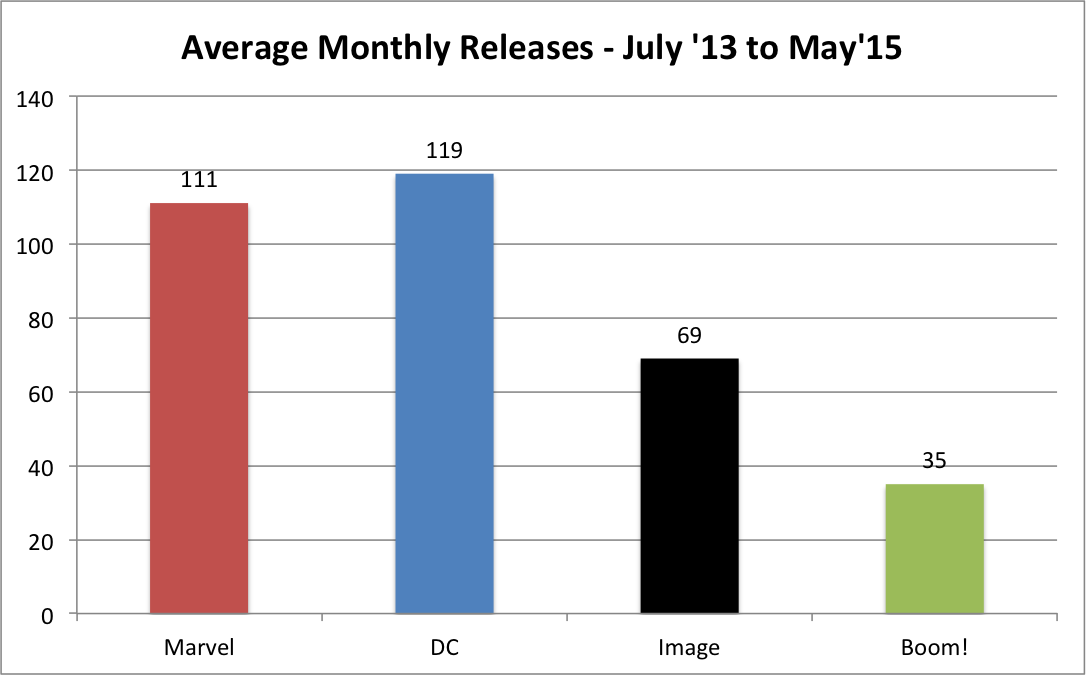
Despite being a clear tier below Marvel most months, sales wise, DC is releasing more comics and graphic novels than them. It’s releasing significantly more even, and DC’s total release list just continues to grow.
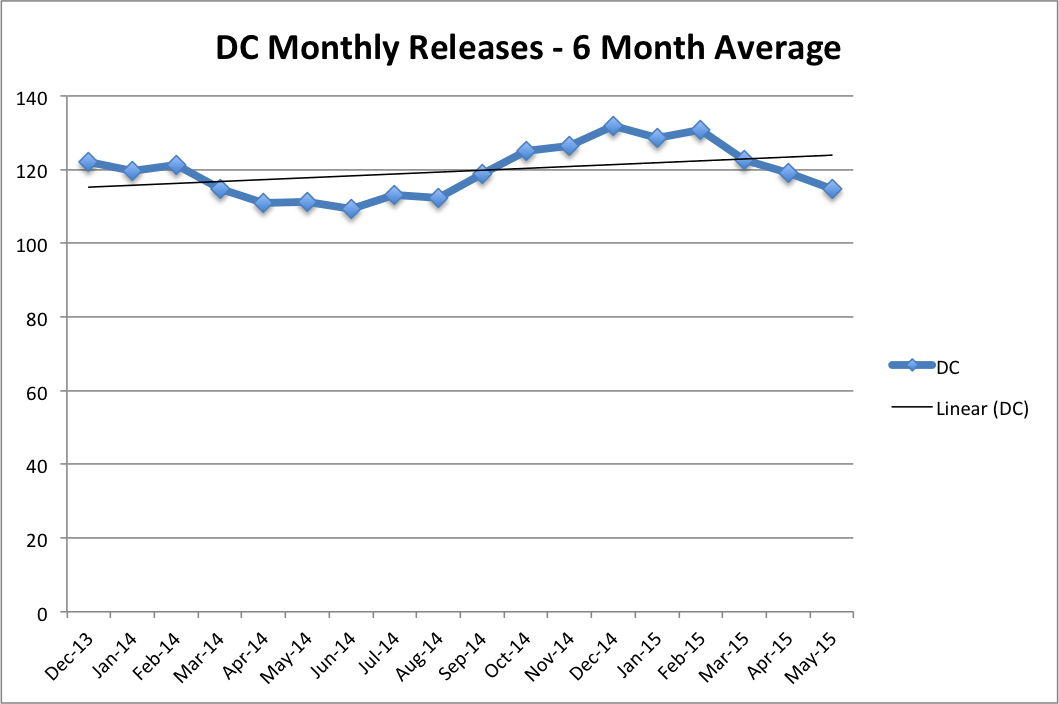
Over the past two years, DC’s total amount of releases – comics, trades and graphic novels – has continued to trend upwards when you look at a six-month rolling average. That’s especially impressive considering how much of a drop they’ve seen in recent months. Again, that’s not a major concern by itself – after all, the industry as a whole is releasing more and more comics – but when you pair it with the dropping revenue numbers for DC, things start looking less peachy.
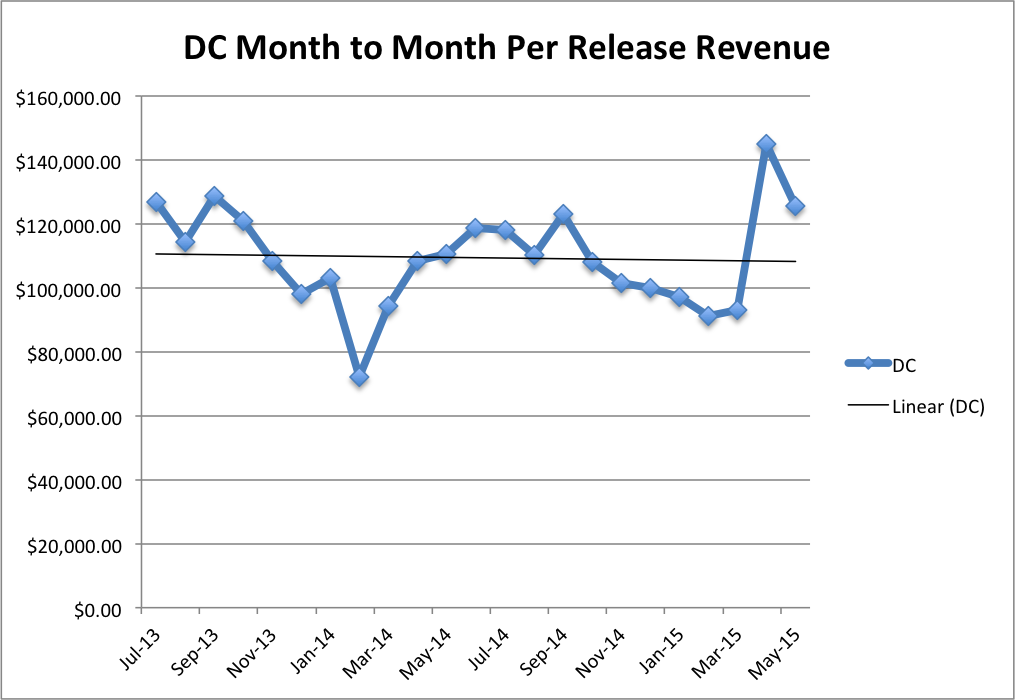
You could have done this part without me, as it’s simple math, but DC’s per release revenue is dropping dramatically, and has been for some time. That’s even more amazing when you consider how the spikes in April and May make that linear trend appear better than it would have otherwise—how crazy do those spikes seem relative to the rest of the chart?—and that the average cost of comics has increased by 34 cents over that span (which is likely even higher for DC, who no longer holds the line at $2.99).
So let’s run it back:
1. DC is trending downwards in terms of revenue
2. DC is progressively releasing more comics
3. Because of those two, they’re making less per comic
4. That’s despite comics being more expensive than they used to be
That’s not great, Bob.
Looking in the Mirror
In business school, I learned a lot about economic principles. One of the most basic and well known is the law of diminishing returns, which states that if production of something continues to increase but everything else remains fixed, by definition, there would be less return per product. It’s a central tenet of economics, and something that fits DC’s current plight. But really, it doesn’t, as DC isn’t just producing more, it’s making less money in whole and per comic despite the rising cost of comics.
Is it any surprise that DC is launching 24 new titles this month after wiping out the vast majority of its under performing books?
Part of the problem lies with DC holding onto releasing 52 titles a month for so long. That alone kept its volume of releases at a high level and ensured they had a lot of comics in their line that had questionable commercial prospects. It’s the nature of comics to sell less as they grow older, and DC’s line continued to age post New 52. Perhaps the biggest thing, though. Much of the New 52 line just wasn’t very good, and the volume of bad comics is more impactful to its sales numbers than the amount they’re releasing overall. After all, you don’t see Snyder and Capullo’s Batman struggling.
The fact of the matter is that save for a few gimmick oriented months, DC’s sales performance has been a quiet problem for a while, and one they’re creating themselves in many ways. Their dedication to releasing more and more titles despite decreasing return per book is not unlike attempting to put out a fire by pouring gasoline on it. It doesn’t work, in concept or reality.
Because of the lack of success their regular practices have, those stunt months have become fixtures in DC’s calendar. Whether its lenticular covers or a nostalgic look back to its past, DC’s orders increase during those months, and we’re seeing them more and more. I take that as equal parts condemnation on the voluminous nature of DC’s regular line and the sales appeal of those less narrative driven months, but either way, it seems apparent: different is better for DC.
One thing I find to be very fascinating about the last chart—the revenue per release per month one—is that by far two of the biggest months on it were the Convergence months. The months where DC returned to the stories of its past and released less titles than usual. Retailers responded the strongest when DC abandoned their go-for-broke New 52 endeavor—which was meant to simplify things for readers—and embraced its complicated past featuring characters and stories near and dear to readers (and retailers) hearts. What did we learn? Less titles that are more familiar work well for DC, or at least in bursts.
After Convergence, they’ve moved back to the Multiverse and launched a bevy of new titles featuring old favorites and others in new packages. It’s uncertain whether those new books will turn the tide for them and deliver a lasting success that the New 52 never seemed to reach. According to John Hendrick of The Big Bang in Dublin, Ireland, the results haven’t been great so far:
“Generally with new number ones, they’re easy enough sells, but customers are really not responding to (half) of the new DC output at all. Pre-orders are low with most of the titles, even the ones that do okay, but because of this we’ll be keeping a very keen eye going forward with orders.”
While he noted Hellblazer and Black Canary have sold well, that’s not a promising start. Considering that new number ones tend to do well and Hendrick’s shop is known for being more proactive, it might be even more foreboding. That said, we’re still talking about just one shop. Time will tell as to how these books perform overall, and if they’re more of what they’re hoping for or what the New 52 eventually did. But if it often seems DC is grasping at straws trying to figure things out, we at least now have a good idea why.
All numbers are based off of Comichron data and calculations created on my own. They are not based off of true, final sales numbers, but estimates. However, the baseline is accurate and at least provides insight into the direction of DC. Also worth noting, these numbers are orders from retailers from Diamond for DC Comics products, not sales to readers. That data doesn’t exist, sadly.
